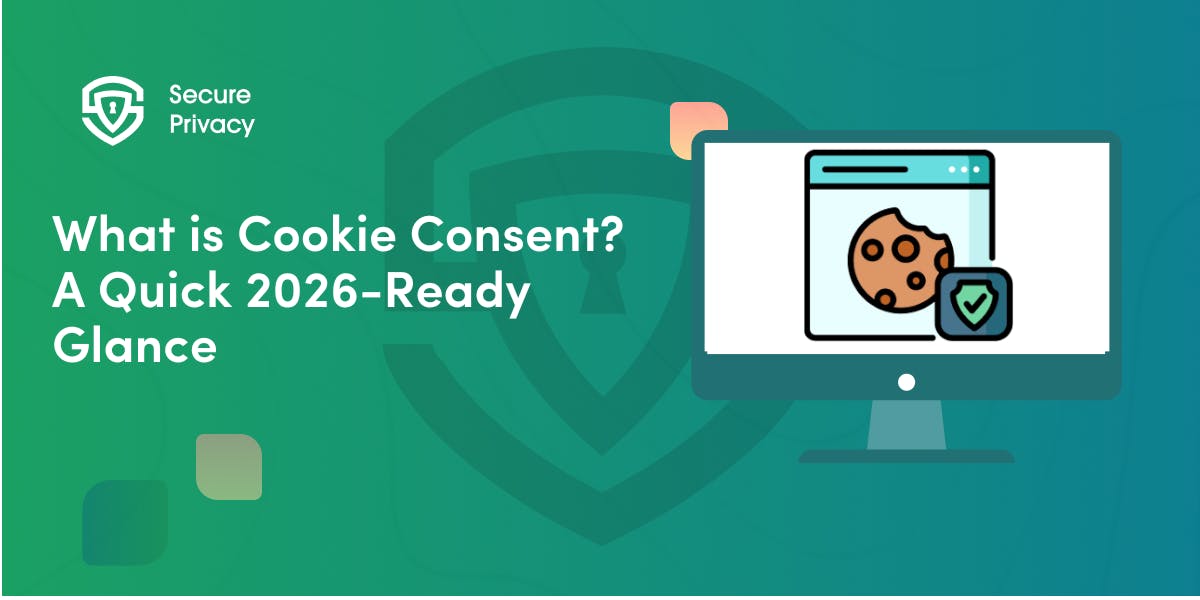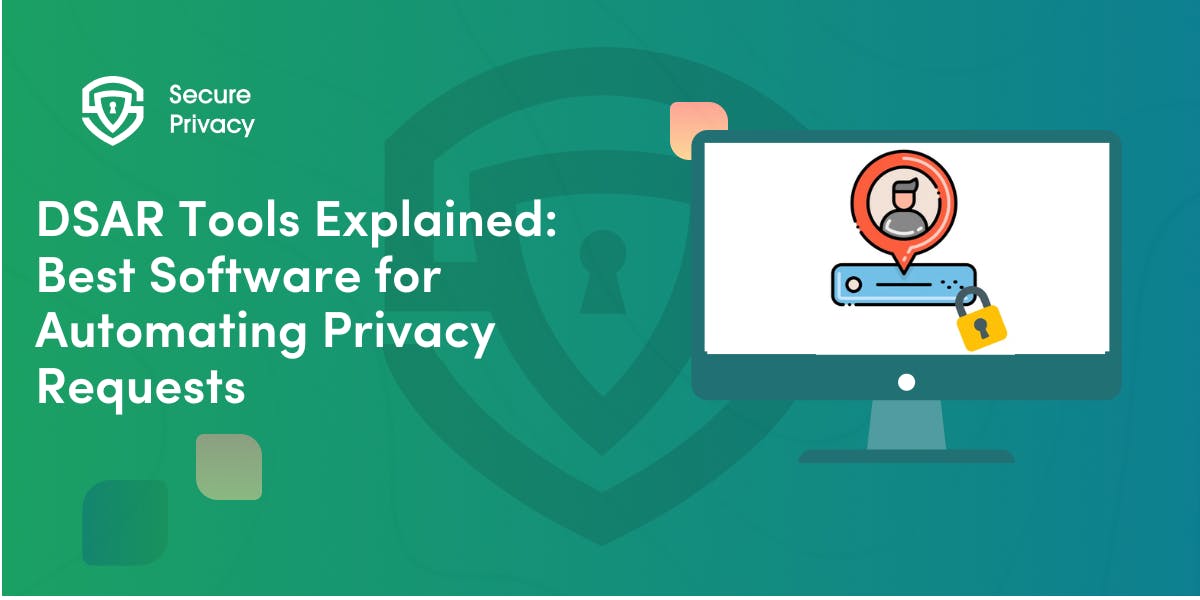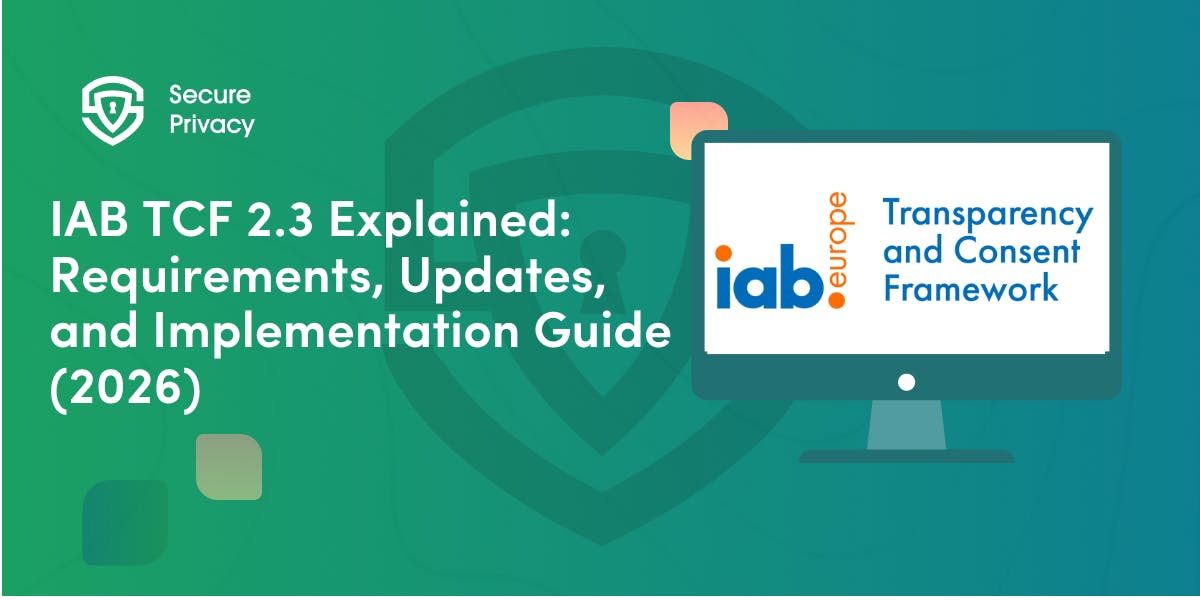Peru Data Protection Law: Compliance Guide for Businesses in 2025
Businesses operating in Peru face growing pressure to protect customer data as new privacy rules take effect. The Peru data protection law has undergone major updates in 2025, creating stricter requirements that could result in significant fines for non-compliant organizations.
Overview of Peru's Personal Data Protection Law
Peru's data privacy landscape changed dramatically in 2025 with new regulations that strengthen the original Personal Data Protection Law No. 29733 from 2011. On November 30, 2024, Supreme Decree No. 016-2024-JUS was published, approving comprehensive updates that took effect on March 30, 2025.

Prioritizing user privacy is essential. Secure Privacy's free Privacy by Design Checklist helps you integrate privacy considerations into your development and data management processes.
Key Changes in the 2025 Update
The new regulation completely replaces the previous 2013 framework and introduces several important changes:
Expanded Territorial Scope: The law now applies to foreign companies that offer services to Peruvian customers or analyze behavior of individuals in Peru. These organizations must appoint a local representative to maintain contact with authorities.
Enhanced Security Requirements: Organizations must implement technical and organizational measures aligned with ISO/IEC 27001 standards to protect personal data.
Stronger Transparency Rules: Privacy notices must be clear, easily understandable, and provide comprehensive information about data processing activities.
Breach Notification Requirements: Companies must report data security incidents to both the National Authority for Personal Data Protection (ANPD) and affected individuals.
Peru vs. GDPR: How They Compare
Many businesses wonder how Peru's privacy rules compare to Europe's General Data Protection Regulation (GDPR). While Peru's law draws inspiration from GDPR, it maintains several distinct characteristics that make compliance more manageable for smaller organizations.
Similarities to GDPR
Peru's updated framework incorporates several GDPR-like elements:
- Data Protection Officer Requirements: Certain organizations must appoint privacy officers based on revenue thresholds
- Proactive Accountability: Companies must demonstrate compliance through documentation and security measures
- Cross-Border Transfer Restrictions: International data transfers require appropriate safeguards
Key Differences from GDPR
However, Peru's approach differs from GDPR in important ways:
- Revenue-Based Thresholds: Data Protection Officer requirements apply based on company size, ranging from 150 to 2,300 Tax Units (UIT)
- Lower Maximum Fines: Penalties are significantly lower than GDPR's potential 4% of global revenue
- Phased Implementation: Smaller businesses have until 2028 to fully comply with certain requirements
Data Subject Rights Under Peru's Law
Peru's Personal Data Protection Law grants individuals comprehensive rights known as ARCO, similar to European privacy standards.
The ARCO Framework
ARCO stands for the four core rights individuals have regarding their personal data:
Access (Acceso): Customers can request information about how their personal data is being processed, including the purposes, recipients, and retention periods.
Rectification (Rectificación): Individuals have the right to correct inaccurate personal data held by organizations.
Cancellation (Cancelación): Data subjects can request deletion of their personal data when processing is unlawful or unnecessary.
Opposition (Oposición): People can object to data processing for justified reasons, particularly for marketing purposes.
ANPD Enforcement and Penalties
The Autoridad Nacional de Protección de Datos Personales (ANPD) serves as Peru's primary data protection authority. Operating under the Ministry of Justice and Human Rights, ANPD has demonstrated active enforcement of privacy rules.
In 2023, ANPD issued over 2.7 million soles in fines and resolved 272 personal data complaints, showing the authority's commitment to protecting individual privacy rights.
Penalty Structure
The updated regulation establishes a comprehensive sanctions framework with two main categories:
Minor Infractions (up to approximately $7,000):
- Failure to respond to ARCO requests within legal timeframes
- Inadequate privacy notices or consent mechanisms
- Minor security measure deficiencies
Serious Infractions (up to approximately $70,000):
- Failure to provide adequate information about data processing
- Unlawful international data transfers
- Significant security breaches due to negligence
- Repeat violations of privacy requirements
The penalty structure includes specific provisions for repeat offenders, with escalating fines for organizations that fail to address compliance issues promptly.
Key Compliance Obligations
Businesses operating in Peru must implement several key measures to comply with the updated Personal Data Protection Law. These requirements apply to both domestic companies and foreign organizations serving Peruvian customers.
Data Processing Registration: Organizations must register their databases and processing activities with ANPD. But, good news! Registration is now free!
Consent Management: Companies must obtain explicit, informed consent for data processing activities. Consent must be specific, freely given, and easily withdrawn.
Privacy Notices: Organizations must provide clear, comprehensive information about their data processing activities, including purposes, legal bases, and individual rights.
Security Measures: Businesses must implement appropriate technical and organizational measures to protect personal data, aligned with international standards like ISO/IEC 27001.
Cross-Border Transfer Safeguards: International data transfers require adequate protection measures, such as standard contractual clauses or adequacy decisions.
Breach Response Procedures: Companies must have processes in place to detect, investigate, and report data security incidents to authorities and affected individuals.
Data Protection Officer Requirements
The 2025 regulation introduces phased requirements for appointing Data Protection Officers based on company revenue:
- Large Companies (>2,300 UIT or ~$3.28M annually): Must appoint DPO by November 30, 2025
- Medium Companies (1,700-2,300 UIT): Deadline of November 30, 2026
- Small Companies (150-1,700 UIT): Deadline of November 30, 2027
- Micro Companies (<150 UIT): Deadline of November 30, 2028
This phased approach gives smaller businesses time to develop compliance capabilities while ensuring larger organizations with greater privacy risks meet requirements sooner.
Common Compliance Challenges
Many organizations struggle with specific aspects of Peru data protection law compliance. Understanding these challenges helps businesses prepare more effectively and avoid common pitfalls.
Multi-Entity Compliance Complexity
Companies with subsidiaries or complex corporate structures often struggle to maintain consistent privacy practices across all entities. Each organization must register its processing activities separately and ensure coordinated compliance efforts.
Cross-Border Data Transfer Compliance
Managing international data flows while meeting Peru's transfer requirements creates operational challenges. Companies must implement appropriate safeguards and maintain documentation for cross-border data movements.
Consent Management Across Digital Channels
Obtaining and managing valid consent across websites, mobile apps, and other digital touchpoints requires sophisticated technical solutions. Organizations must ensure consent mechanisms meet legal requirements while providing good user experiences.
Vendor and Third-Party Compliance
Many businesses rely on external service providers for data processing activities. Ensuring these vendors comply with Peru data protection law requirements through appropriate contracts and oversight creates additional compliance burdens.
Technology Solutions for Peru Privacy Compliance
Modern compliance relies heavily on technology solutions that can automate key processes and provide audit-ready documentation. Different types of software tools can help organizations meet Peru data protection law requirements more efficiently.
Consent Management Platforms
Consent management platforms help organizations obtain, record, and manage customer consent for data processing activities. These solutions typically include:
- Customizable Consent Banners: User-friendly interfaces that meet Peru's explicit consent requirements
- Preference Centers: Allows individuals to manage their privacy preferences and withdraw consent easily
- Audit Documentation: Maintains records of consent decisions for regulatory compliance purposes
- Multi-Language Support: Essential for businesses serving diverse Peruvian markets
Leading consent management solutions include enterprise platforms like OneTrust (starting around $50,000 annually) and mid-market options like Osano ($199/month) and Enzuzo.
Records of Processing Activities (RoPA) Management
Organizations must maintain detailed records of their data processing activities. RoPA management tools help businesses:
- Document Processing Activities: Capture all required information about data processing purposes, categories, and retention periods
- Generate Compliance Reports: Automatically create documentation for ANPD registration and audits
- Track Data Flows: Map how personal data moves through organizational systems and to third parties
- Monitor Compliance Status: Identify gaps in compliance and track remediation efforts
Data Subject Rights Management
Handling ARCO rights requests efficiently requires specialized tools that can:
- Automate Request Processing: Streamline intake and routing of individual rights requests
- Search Across Systems: Identify and retrieve personal data from multiple databases and applications
- Generate Response Documentation: Create appropriate responses that meet legal requirements
- Track Response Times: Ensure organizations meet legal deadlines for responding to requests
Privacy Impact Assessment Tools
For high-risk data processing activities, organizations may need to conduct privacy impact assessments. Specialized tools help businesses:
- Identify Privacy Risks: Systematically evaluate potential impacts of processing activities
- Document Mitigation Measures: Record steps taken to reduce privacy risks
- Generate Assessment Reports: Create comprehensive documentation for internal use and regulatory purposes
How Secure Privacy Supports Compliance
Comprehensive privacy governance platforms combine multiple compliance tools into integrated solutions. These platforms help organizations manage Peru data protection law requirements alongside other global privacy regulations.
Key Benefits
Centralized Compliance Management: Single dashboard for monitoring compliance across multiple privacy laws and jurisdictions.
Automated Workflows: Streamlined processes for consent management, rights requests, and breach response.
Audit-Ready Documentation: Comprehensive records that demonstrate compliance efforts to regulators.
Risk Assessment Capabilities: Tools to identify and prioritize privacy risks across organizational operations.
Vendor Management: Features to monitor and manage third-party compliance through contracts and assessments.
Localization for Peru Markets
Effective privacy governance software for Peru should include:
- Spanish Language Support: User interfaces and documentation in Spanish for local teams
- ANPD Registration Integration: Tools that facilitate database registration and reporting requirements
- Local Legal Updates: Regular updates reflecting changes in Peru privacy law and ANPD guidance
- Currency and Date Formats: Appropriate formatting for Peruvian business requirements
Implementation Roadmap for Peru Privacy Compliance
Organizations should follow a structured approach to achieve Peru data protection law compliance. This roadmap prioritizes essential requirements while building comprehensive privacy management capabilities.
Phase 1: Foundation Building (Months 1-3)
Data Discovery and Mapping: Conduct comprehensive audits to identify all personal data processing activities. Document data sources, processing purposes, and retention periods.
Privacy Policy Updates: Revise privacy notices to meet Peru data protection law transparency requirements. Ensure policies clearly explain processing activities and individual rights.
Consent Mechanism Review: Evaluate existing consent collection processes and update them to meet explicit consent requirements under Peru data protection law.
ANPD Registration: Complete database registration with ANPD for all processing activities.
Phase 2: Operational Implementation (Months 4-6)
Rights Request Procedures: Establish processes for handling ARCO rights requests, including intake, investigation, and response procedures.
Security Measure Enhancement: Implement technical and organizational measures aligned with ISO/IEC 27001 standards.
Vendor Assessment: Review and update contracts with third-party service providers to ensure appropriate data protection clauses.
Breach Response Planning: Develop incident response procedures that meet ANPD notification requirements. teams on privacy rights requirements.
Security Measure Enhancement: Implement technical and organizational measures aligned with ISO/IEC 27001 standards. Document security policies and procedures for audit purposes.
Vendor Assessment: Review and update contracts with third-party service providers to ensure appropriate data protection clauses. Conduct privacy assessments of key vendors.
Breach Response Planning: Develop incident response procedures that meet ANPD notification requirements. Train relevant teams on breach detection and reporting processes.
Phase 3: Advanced Compliance (Months 7-12)
Data Protection Officer Appointment: Based on your organization's revenue threshold, prepare for DPO appointment within required timeframes. Define responsibilities and reporting relationships.
Privacy Impact Assessment Process: Establish procedures for conducting privacy impact assessments for high-risk processing activities. Create templates and evaluation criteria.
Cross-Border Transfer Documentation: Implement appropriate safeguards for international data transfers. Maintain documentation of transfer mechanisms and adequacy determinations.
Ongoing Monitoring and Training: Develop regular compliance monitoring processes and privacy awareness training programs for employees.
Conclusion
Peru's updated data protection law represents a significant step forward in Latin American privacy regulation. The 2025 changes create stronger protections for individuals while providing businesses with clear compliance requirements and reasonable implementation timelines.
Success in Peru privacy compliance requires a combination of policy updates, process improvements, and technology solutions. Privacy governance software can significantly streamline compliance efforts by automating key processes and providing audit-ready documentation.
[Book a demo] to see how automated compliance solutions can reduce your regulatory risks while improving operational efficiency.
Get Started For Free with the
#1 Cookie Consent Platform.
No credit card required

What is Cookie Consent? A Quick 2026-Ready Glance
Your website loads. Cookies track users. But without proper cookie consent, you're violating GDPR — risking fines up to €20 million or 4% of global revenue. Cookie consent is the legally required mechanism by which websites obtain explicit user approval before deploying non-essential tracking technologies. This requirement stems from GDPR Article 4(11) and the ePrivacy Directive, mandating that consent must be freely given, specific, informed, and unambiguous.
- Legal & News

DSAR Tools Explained: Best Software for Automating Privacy Requests
You're drowning in data subject access requests. Manual searches through dozens of systems miss regulatory deadlines and expose organizations to fines starting at $2,500 per violation. The solution? DSAR tools — purpose-built software that automates the entire process of responding to data subject access requests, from intake to delivery.
- Legal & News

IAB TCF 2.3 Explained: Requirements, Updates, and Implementation Guide (2026)
Your ad revenue dropped 40% overnight. Google stopped bidding on your inventory. Your DSP partners flagged your traffic as non-compliant. The culprit? An outdated TCF 2.2 consent string after the February 2026 enforcement deadline.
- Legal & News
- Cookie Consent
